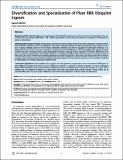Por favor, use este identificador para citar o enlazar a este item:
http://hdl.handle.net/10261/26751COMPARTIR / EXPORTAR:
 SHARE SHARE
 CORE
BASE CORE
BASE
|
|
| Visualizar otros formatos: MARC | Dublin Core | RDF | ORE | MODS | METS | DIDL | DATACITE | |

| Título: | Diversification and Specialization of Plant RBR Ubiquitin Ligases |
Autor: | Marín, Ignacio CSIC ORCID | Fecha de publicación: | 14-jul-2010 | Editor: | Public Library of Science | Citación: | PLoS One 5(7): e11579 (2010) | Resumen: | BACKGROUND: RBR ubiquitin ligases are components of the ubiquitin-proteasome system present in all eukaryotes. They are characterized by having the RBR (RING - IBR - RING) supradomain. In this study, the patterns of emergence of RBR genes in plants are described. METHODOLOGY/PRINCIPAL FINDINGS: Phylogenetic and structural data confirm that just four RBR subfamilies (Ariadne, ARA54, Plant I/Helicase and Plant II) exist in viridiplantae. All of them originated before the split that separated green algae from the rest of plants. Multiple genes of two of these subfamilies (Ariadne and Plant II) appeared in early plant evolution. It is deduced that the common ancestor of all plants contained at least five RBR genes and the available data suggest that this number has been increasing slowly along streptophyta evolution, although losses, especially of Helicase RBR genes, have also occurred in several lineages. Some higher plants (e. g. Arabidopsis thaliana, Oryza sativa) contain a very large number of RBR genes and many of them were recently generated by tandem duplications. Microarray data indicate that most of these new genes have low-level and sometimes specific expression patterns. On the contrary, and as occurs in animals, a small set of older genes are broadly expressed at higher levels. CONCLUSIONS/SIGNIFICANCE: The available data suggests that the dynamics of appearance and conservation of RBR genes is quite different in plants from what has been described in animals. In animals, an abrupt emergence of many structurally diverse RBR subfamilies in early animal history, followed by losses of multiple genes in particular lineages, occurred. These patterns are not observed in plants. It is also shown that while both plants and animals contain a small, similar set of essential RBR genes, the rest evolves differently. The functional implications of these results are discussed. | Descripción: | 14 pages, 7 figures, 1 table. PMID: 20644651 [PubMed]PMCID: PMC2904391 Free PMC Article | Versión del editor: | http://dx.doi.org/10.1371/journal.pone.0011579 | URI: | http://hdl.handle.net/10261/26751 | DOI: | 10.1371/journal.pone.0011579. | ISSN: | 1932-6203 |
| Aparece en las colecciones: | (IBV) Artículos |
Ficheros en este ítem:
| Fichero | Descripción | Tamaño | Formato | |
|---|---|---|---|---|
| Plos One 005-e11579.pdf | 2,62 MB | Adobe PDF |  Visualizar/Abrir |
CORE Recommender
Page view(s)
306
checked on 13-may-2024
Download(s)
228
checked on 13-may-2024
Google ScholarTM
Check
Altmetric
Altmetric
NOTA: Los ítems de Digital.CSIC están protegidos por copyright, con todos los derechos reservados, a menos que se indique lo contrario.
